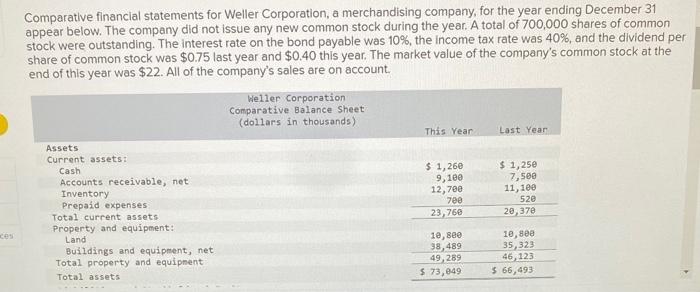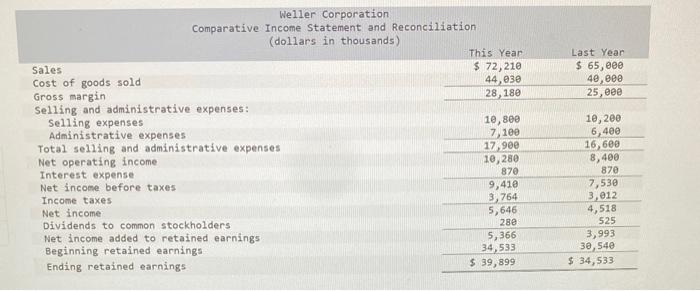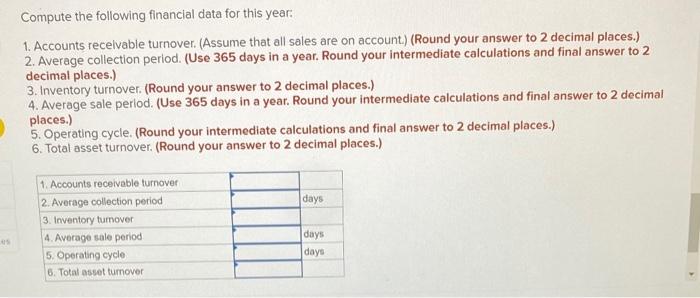Comparative financial statements for Weller Corporation, a merchandising company, for the year ending December 31 appear below. The company did not issue any new common stock during the year. A total of 700,000 shares of common stock were outstanding. The interest rate on the bond payable was 10%, the income tax rate was 40%, and the dividend per share of common stock was $0.75 last year and $0.40 this year. The market value of the company's common stock at the end of this year was $22. All of the company's sales are on account. Total property and equipment Total assets \begin{tabular}{rr} 49,289 & 46,123 \\ \hline$73,049 & $66,493 \\ \hline \end{tabular} Liabilities and Stockholders' Equity current liabilities: Accounts payable Accrued liabilities Notes payable, short term Total current liabilities \begin{tabular}{rr} $18,60 & $17,76 \\ 1,00 & 710 \\ 150 & 150 \\ \hline 19,750 & 18,56 \end{tabular} Long-term liabilities: Bonds payable Total liabilities \begin{tabular}{rr} 8,700 & 8,790 \\ \hline 28,450 & 27,260 \\ \hline \end{tabular} Stockholders' equity: Common stock Additional paid-in capital Total paid-in capital Retained earnings Total stockholders' equity Total liabilities and stockholders' equity Weller Corporation Comparative income Statement and Reconciliation (dollars in thousands) Weller corporation Comparative Income Statement and Reconciliation (dollars in thousands) Sales Cost of goods sold Gross margin Selling and administrative expenses: Selling expenses Administrative expenses Total selling and administrative expenses Net operating income Interest expense Net income before taxes Income taxes Net income Dividends to common stockholders Net income added to retained earnings Beginning retained earnings Ending retained earnings \begin{tabular}{|rr} \hline This Year & Last Year \\ $72,21 & $65,0 \\ 44,3 & 40,0 \\ \hline 28,180 & 25,0 \\ \hline & \\ 10,80 & 1,200 \\ \hline 7,10 & 6,400 \\ \hline 17,90 & 16,60 \\ \hline 10,280 & 8,40 \\ 870 & 87 \\ \hline 9,41 & 7,530 \\ 3,764 & 3,12 \\ \hline 5,646 & 4,518 \\ 280 & 525 \\ \hline 5,366 & 3,993 \\ \hline 34,533 & 30,54 \\ \hline 539,899 & $34,533 \\ \hline \end{tabular} Compute the following financial data for this year: 1. Accounts recelvable turnover. (Assume that all sales are on account) (Round your answer to 2 decimal places.) 2. Average collection period. (Use 365 days in a year. Round your intermediate calculations and final answer to 2 decimal places.) 3. Inventory turnover. (Round your answer to 2 decimal places.) 4. Average sale perlod. (Use 365 days in a year. Round your intermediate calculations and final answer to 2 decimal places.) 5. Operating cycle. (Round your intermediate calculations and final answer to 2 decimal places.) 6. Total asset turnover. (Round your answer to 2 decimal places.)










